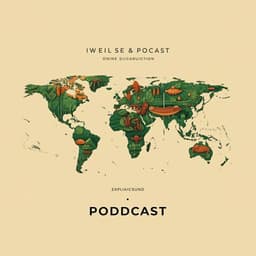
Environmental Studies and Forestry
Contrasting inequality in human exposure to greenspace between cities of Global North and Global South
B. Chen, S. Wu, et al.
This study conducted by Bin Chen, Shengbiao Wu, Yimeng Song, Chris Webster, Bing Xu, and Peng Gong reveals startling global disparities in urban greenspace access, especially between Global North and South cities. With Global South residents experiencing only one-third the greenspace exposure, this research emphasizes the urgent need for equitable greening policies to combat environmental inequalities.
~3 min • Beginner • English
Introduction
The study addresses how far the world is from achieving SDG 11’s target of universal access to urban greenspace by moving beyond simple greenspace provision metrics to quantify actual human exposure. Existing coverage or per-capita measures often assume uniform population distribution and ignore accessibility and seasonality, potentially producing ecological fallacies. The authors aim to quantify spatially explicit, population-weighted exposure to greenspace at multiple administrative scales and across 1,028 large cities, contrast Global North versus Global South patterns, and examine seasonal dynamics. The research specifically asks: (1) What are the differences in human exposure to greenspace across countries, states, and counties globally? (2) How do greenspace exposure levels and inequalities differ among global cities and what are their drivers? (3) How does vegetation seasonality affect greenspace exposure and inequality?
Literature Review
Prior work has typically used greenspace supply or accessibility metrics (e.g., total coverage, per-capita provision, proportion of population within 300 m of greenspace) to assess progress toward urban sustainability and health goals. However, these approaches often: (a) equate access with equal share, not accounting for the actual amount of greenspace individuals are exposed to; (b) exclude smaller but important greenspace types (e.g., street trees, lawns, small parks) due to area thresholds; and (c) cannot quantify spatially explicit inequality in exposure. Evidence from the U.S., Germany, Brazil, and China indicates substantial disparities in greenspace supply and access, underscoring the need for consistent, globally comparable exposure assessments that consider both greenspace and population distributions as well as seasonality (e.g., Huang et al., 2021; Long et al., 2022).
Methodology
Design: Global, multi-scale analysis combining high-resolution greenspace mapping with gridded population data to compute population-weighted greenspace exposure and inequality (Gini) across countries, states, counties, and 1,028 large urban areas (continuous built-up areas ≥100 km²). Seasonal analyses assess phenology effects on exposure and inequality.
Data and units:
- Administrative units: FAO Global Administrative Unit Layers (GAUL, 2015) at country, state, county levels.
- Urban areas: Global Urban Boundaries (2018) representing continuous built-up areas; 1,028 cities selected (522 Global North, 506 Global South).
- Population: WorldPop 2020, 100 m resolution.
- Greenspace: ESA WorldCover 2020, 10 m resolution; greenspace includes forest, shrub, grass, herbaceous wetland, and mangrove classes.
Processing:
- Greenspace coverage: Aggregate 10 m WorldCover to 100 m fractional greenspace to align with population grids; compute physical greenspace coverage (GC) as the mean fraction across grids within each unit.
- Human exposure to greenspace: Population-weighted exposure GE = (Σ P_i G_i) / (Σ P_i), where G_i is fractional greenspace in grid i considering a circular buffer of radius d around each grid (primary: 500 m; sensitivity: 100, 1000, 1500 m), and P_i is population of grid i.
- Inequality: Compute Gini index of greenspace exposure across grids within each city following Song et al.; Gini from 0 (equality) to 1 (inequality).
- Seasonal analysis: Build seasonal (spring, summer, autumn, winter; hemisphere-adjusted) Sentinel-2 composites; classify vegetation with random forest; compute seasonal exposure and Gini; quantify spatiotemporal variation via coefficient of spatial variation csv = σ/μ for each season and overall seasonal variation cstv = std(csv_i).
Model validation:
- Create Sentinel-2 yearly maximum NDVI composites; mask clouds/shadows using S2 cloud probability; train RF classifier (15 trees; 3,607 training samples) to derive vegetation/non-vegetation maps; validate with 20,526 samples (overall accuracy 0.95, precision 0.94, recall 0.95, F1 0.95). Use Sentinel-2-derived greenspace fraction, exposure, and Gini as benchmarks to assess WorldCover-derived metrics (high correlation; near-unity slopes). Differences attributed to seasonality.
Statistical analysis of drivers:
- Multiple linear regressions relating city-level Gini to covariates: geographic (latitude), climate (precipitation, vapor pressure deficit), landscape (greenspace coverage rate, edge density), plus topographic and socioeconomic categories considered. Partition variance to quantify unique and joint contributions (e.g., provision vs configuration).
Sensitivity:
- Evaluate impact of buffer radius on exposure rankings at country, state, county levels (100–1500 m).
Key Findings
- Global exposure levels: At country level, 45.8% of countries/regions have exposure <50%, and 21.0% <25%. For the 10 most populous countries: China 26.5%, India 24.3%, US 58.0%, Indonesia 58.7%, Pakistan 12.2%, Brazil 39.4%, Nigeria 47.2%, Bangladesh 35.4%, Russia 54.0%, Mexico 28.6%.
- Scale patterns: At state level, 41.6% (<50%) and 17.0% (<25%); at county level, 37.2% (<50%) and 15.9% (<25%). Exposure is consistently lower than physical greenspace coverage, indicating overestimation when using coverage alone.
- Buffer sensitivity: Changing buffer from 500 m to 1500 m yields small average discrepancies in exposure rankings: countries 0.56%, states 0.48%, counties 2.63%.
- Global North vs South: Cities in the Global North exhibit much higher exposure (mean 45.84%) than the Global South (mean 14.39%). Inequality is nearly double in the South (Gini 0.47) versus North (Gini 0.24–0.27). By continent: North America 53.45% (Gini 0.21), Europe 39.25% (0.26), Australia/Oceania 42.51% (0.22), South America 19.89% (0.41), Africa 17.66% (0.46), Asia 13.49% (0.47). Global mean across 1,028 cities: 30.36% exposure, Gini 0.35.
- Seasonality: Largest discrepancy in city Gini between summer and winter (R² = 0.13 for summer vs winter Gini regression). The change in inequality (winter–summer Gini) is strongly associated with the change in spatiotemporal variation of exposure (Δσ/μ): R² = 0.59, p < 0.01.
- Greenspace types: Tree exposure dominates total urban greenspace exposure globally (68.66% on average) with strong correlation to total exposure (R² = 0.91).
- Drivers of inequality: Landscape factors dominate. Greenspace landscape (provision and configuration) explains most variation in city Gini (Adjusted R² = 79.0% in landscape-only model). In variance partitioning, greenspace coverage rate (provision) uniquely explains 21.93%, edge density (configuration) uniquely 3.68%, and jointly 53.42% of inequality variation. In full models, significant associations include latitude, precipitation (negative), vapor pressure deficit (positive), greenspace coverage rate (negative), and edge density (negative), with overall adjusted R² up to 81.1%.
- Examples: New York City has 58.01% greenspace coverage but only 25.73% exposure; Billings, US: 46.79% coverage with 48.89% exposure, illustrating overestimation by coverage alone.
Discussion
By integrating population distributions with fine-scale greenspace mapping, the study provides a realistic measure of human exposure, revealing stark global disparities: Global South cities have substantially lower exposure and higher inequality. This directly addresses the research questions by demonstrating multi-scale heterogeneity, identifying the magnitude and geography of city-level disparities, and quantifying how seasonality modulates inequality. The dominance of landscape drivers implies that both the amount (provision) and spatial configuration of greenspace are critical for equitable exposure. Higher provision and more fragmented/edge-rich configurations tend to reduce inequality when green is distributed closer to where people live. Seasonal phenology, especially differences between evergreen and deciduous systems and wet/dry climates, introduces temporal variability in exposure and inequality, suggesting that assessments and interventions should consider seasonal dynamics. Findings are relevant for urban planning and public health: aggregate coverage or per-capita targets can be misleading; what matters is the spatial match between greenspace and population to ensure equitable benefits.
Conclusion
The paper establishes a globally consistent, population-weighted framework to quantify human exposure to greenspace and its inequality across multiple scales and seasons. It documents a strong Global North–South contrast: Global South cities have only about one-third of the exposure of Global North cities and nearly double the inequality. Landscape attributes—especially greenspace provision and its spatial configuration—are the primary determinants of exposure inequality. Policy implications include prioritizing greening in low-exposure, high-inequality areas, moving beyond aggregate green targets toward population-proximate placement, and accounting for seasonal dynamics in planning and evaluation. Future work should integrate human mobility to capture dynamic exposure, incorporate demographic attributes to identify vulnerable groups, and analyze temporal trends under urbanization and climate change to project and manage evolving inequalities.
Limitations
- Static exposure representation: Population and greenspace footprints are treated as static, not capturing daily mobility and dynamic human–greenspace interactions.
- Lack of demographic stratification: Differences by age, race, income, and other sociodemographic factors are not modeled, limiting insights into equity for vulnerable groups.
- Temporal scope: The analysis focuses on 2020 and does not assess long-term changes or trends under socioeconomic and climatic shifts.
- Data and model uncertainties: Differences between WorldCover and Sentinel-2-derived metrics due to seasonality and classification errors; potential biases in population gridding and land cover accuracy; use of buffer-based neighborhood definitions may not capture perceived or actual access barriers.
Related Publications
Explore these studies to deepen your understanding of the subject.







